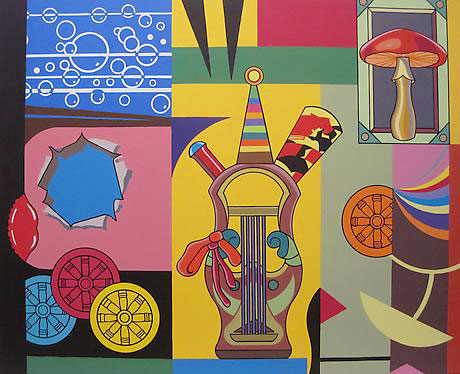Tibor de Nagy Gallery: Trevor Winkfield, Recent Paintings, Nov 29 - Jan 12, 2012 back
Imagine the kinetic jazziness of Stuart Davis, blended with the dry, meticulous wit of René Magritte, and you might come up with something like the paintings of Trevor Winkfield. The artist’s sixteen paintings, currently on view in his seventh exhibition at Tibor de Nagy, reflect his usual proclivity for cryptic arrays of stylized, brightly-hued objects. The effect—for each painting and indeed for the whole exhibition—is of a mischievous kind of connoisseurship: a preternatural revamping of traditions of painting. Picture a playfully electrified curio cabinet.
Through the installation, abstracted images of fish, mushrooms, pagodas, vases and flowers congregate within geometrical spaces of intense, planar color. With their flattened, frontal aspect, Winkfield’s forms suggest a secretive sign-language—and indeed, three paintings with stylized objects dotting white backgrounds were inspired by Mexican codices. In a sense, these three paintings near the front desk set the stage for the rest of the show, in which an exotic language of forms spells out purposeful (if indecipherable) lines of thought.
Though never straying far from the diagrammatic, Winkfield’s renderings also draw upon faithful observations. At points, the mix of the real and the schematic can evoke a kind of urgent nostalgia—a fragmenting afterglow of keen, personal memories. In “Summer Shrine” (2011), for instance, painstakingly observed beads of condensation coat a tumbler of amber-colored liquid. (A mint julep?) The leaves emerging from its top, however, are reduced to cartoonish planes of color, as are a trio of ladybugs around its base. Rows of crinkled, purplish brown forms could be a parade of charcoal briquettes; a ring of orange triangles may or may not be flames. In any case, the assembly of forms summons, with a dream-like fixation on detail, an afternoon of outdoor leisure.
Some paintings more directly address the process of painting itself. In “Aftermath” (2010), the depiction of a ragged “hole” in the canvas’ surface explicitly examines the tensions between the depicted and the real. “The Gallery” (2012) features an array of semi- and completely-abstracted images framed by concentric bands or odd, wafer-like moldings; this process of re-displaying the displayed recalls Pop Art’s commemoration of the generic.
But unlike much Pop art, Winkfield’s paintings seek to compose—if not in the weighted, atmospheric fashion of Matisse, Braque or Chardin, than as counterbalanced graphic elements. Moreover, despite his seamless renderings, Winkfield pursues a more personal attachment to his subjects than did Warhol or Lichtenstein. Could the riddles and double-entendres be the artist’s best vehicle for connecting with the deeply personal? In one painting here, a cluster of mushrooms rhymes with spinning tops and a bird’s spreading wings. In another, shuttlecock-like comets zoom, with urgent whimsy, around a bouquet of butterflies as still as flowers. And at the center of “Aftermath” (2010), elements condense as the likeness of a victrola, or possibly the neck of a guitar. What does it all mean? This last work includes rolling disks that could be wagon wheels or poker chips, an array of peaks sprouting from the victrola’s top like party hats, and that afore-mentioned “hole” in the canvas. Like all the paintings here, it eludes any single interpretation. But in another sense, it tells us all we really need to know: something happened, there were consequences, and an artist saw and remembered.
Tibor de Nagy Gallery
724 Fifth Avenue, New York NY 10019
212-262-5050 · www.tibordenagy.com back
